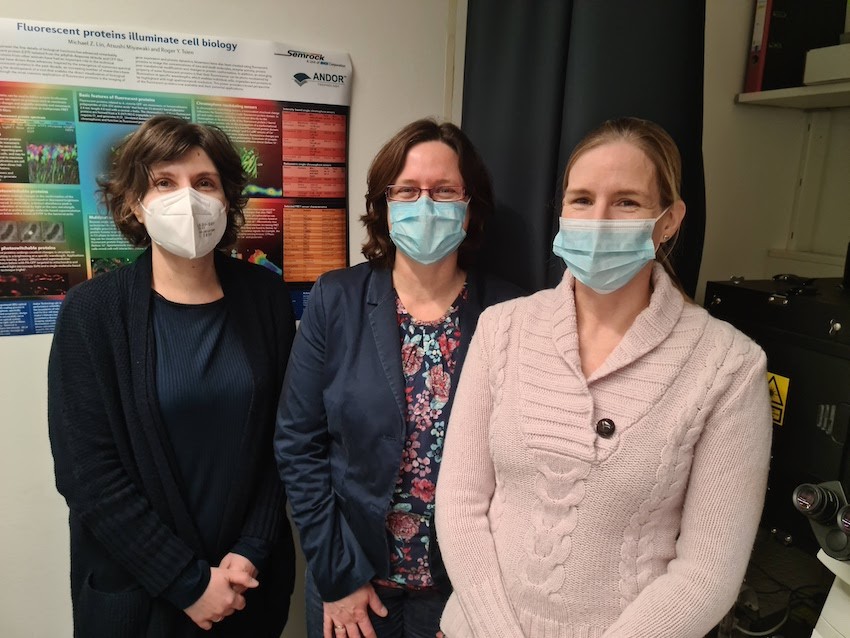Finanziamento - 2020

Gruppo Famiglie Dravet in partnership con Dravet UK, Apoyo Dravet, Dravet Syndrom e. V,
Stichting Dravet Syndroom Nederland/Vlaanderen e Swiss Dravet Syndrome Association
Finanziamento - 2020
|
“Studi funzionali e ultrastrutturali delle interazioni neurone-oligodendroglia e mielinizzazione nella sindrome di Dravet" |
|---|
Nella sindrome di Dravet (SD), l'attività neuronale nel cervello è alterata a causa di mutazioni nel gene SCN1A che codifica per il canale del sodio NaV1.1.
È stato dimostrato che le proprietà di scarica dei neuroni inibitori, che esprimono i canali NaV1.1, è alterata dalle mutazioni di SCN1A. Ciò influisce sulla comunicazione tra i neuroni, portando infine a una minore inibizione e ipereccitabilità.
I neuroni sono incorporati in reti complesse, in contatto tra loro e anche con altri tipi di cellule, come gli oligodendrociti. Gli oligodendrociti sono responsabili delle guaine mieliniche che avvolgono gli assoni di alcuni neuroni. Queste guaine fungono da isolamento, proteggono gli assoni e ne accelerano la loro trasmissione. Sebbene gli oligodendrociti e i loro precursori (OPC) condividano origini embrionali comuni con i neuroni inibitori e interagiscano anche fortemente durante lo sviluppo, finora non è stato studiato se siano anche interessati da mutazioni SCN1A. Nel cervello embrionale, le OPC si sviluppano insieme ai neuroni, ma a differenza dei neuroni mantengono la loro capacità di dividersi e generare nuove cellule per tutta la vita.
Recentemente, è stato descritto che la mielinizzazione è alterata nei pazienti con SD. Nonostante sappiamo che i neuroni inibitori e gli OPC interagiscono tra loro, non è ancora noto come questa interazione sia alterata nella sindrome di Dravet (SD) e quali conseguenze abbiano questi cambiamenti per la funzione cerebrale. Nel nostro progetto, quindi, vogliamo capire come le mutazioni di SCN1A influenzano gli oligodendrociti e la loro interazione con i neuroni, e se la mielinizzazione complessiva nel cervello ne è influenzata.
Le nostre domande chiave quindi sono (i) se, in un modello murino sindrome di Dravet (SD), la distribuzione del canale del sodio NaV1.1 è alterata in parti specifiche del neurone, dove vengono generati e propagati i potenziali d'azione, (ii) se una mutazione SCN1A altera le proprietà fisiologiche in neuroni e OPC e le loro interazioni e (iii) se la mielinizzazione è alterata da mutazioni di SCN1A.
Per rispondere a queste domande, utilizzeremo un microscopio a super risoluzione per essere in grado di analizzare come sono distribuiti i canali ionici nei neuroni, in particolare il canale NaV1.1, e come questa situazione è modificata nelle cellule isolate da un modello murino sindrome di Dravet (SD). Isoleremo e metteremo in coltura neuroni e OPC da topi sani di controllo e da topi con sindrome di Dravet (SD), e contestualmente misureremo la loro attività, valutando anche la loro risposta agli stimoli elettrici. Questo ci permetterà di capire se la loro interazione è alterata dalla mutazione. Inoltre, analizzeremo il cervello di topi giovani e adulti sani di controllo e con sindrome di Dravet (SD) studiando se ci sono differenze nella quantità di mielina.
La nostra ricerca caratterizzerà un nuovo meccanismo fisiopatologico della sindrome di Dravet (SD), le interazioni neurone-oligodendrocita, al fine di sviluppare nuove strategie di trattamento.
Research Grant 2020
|
“Functional and ultrastructural studies of neuron-oligodendroglia interactions and myelination in Dravet syndrome” |
|---|
In Dravet Syndrome (DS), neuronal activity in the brain is altered, which is caused by mutations in the SCN1A gene encoding the sodium channel NaV1.1. It has been shown, that firing properties of inhibitory neurons expressing NaV1.1 channels are altered through SCN1A mutations. This affects communication between neurons ultimately leading to less inhibition and hyperexcitability.
Neurons are embedded in complex networks, contacting each other and but also other cell types, e.g. oligodendrocytes. Oligodendrocytes are responsible for myelin sheaths enwrapping axons of certain neurons. These sheaths serve as wire isolation, they protect axons and speed up their conduction. Although oligodendrocytes and their precursors (OPCs) share common embryonic origins with inhibitory neurons and also highly interact during development, it has so far not been investigated whether they are also affected by SCN1A mutations. In the embryonic brain, OPCs develop along with neurons, but in contrast to neurons they keep their capability to divide and generate new cells throughout life.
Recently, it has been described that myelination is altered in DS patients. Although we know that inhibitory neurons and OPCs interact with each other, it is still unknown how this interaction is altered in DS and what consequences these changes have for brain function. In our project, we therefore want to understand how SCN1A mutations affect oligodendrocytes and their interaction with neurons, and whether the overall myelination in the brain is affected.
Our key questions thus are (i) if the distribution of the sodium channel NaV1.1 at specific parts of the neuron, where action potentials are generated and propagated, is altered in a DS mouse model, (ii) if an SCN1A mutation alters the physiological properties in neurons and OPCs and their interactions, and (iii) if myelination is altered by SCN1A mutations.
To answer these questions, we will use super-resolution microscopy to be able to analyze how ion channels in neurons, especially NaV1.1, are distributed, and how this is changed in cells isolated from a DS mouse model. We will isolate and culture neurons and OPCs from healthy control and DS mice and by co-culturing them, we will measure their activity and assess their response to electrical stimuli. This will shed light on if their interaction is altered by the mutation. In addition, we will analyze brains of juvenile and adult healthy control and DS mice and study whether there are differences in the myelin amount between them.
Our research will characterize a new pathophysiological mechanism of DS, the neuron-oligodendrocyte
interactions, in order to develop new treatment strategies.